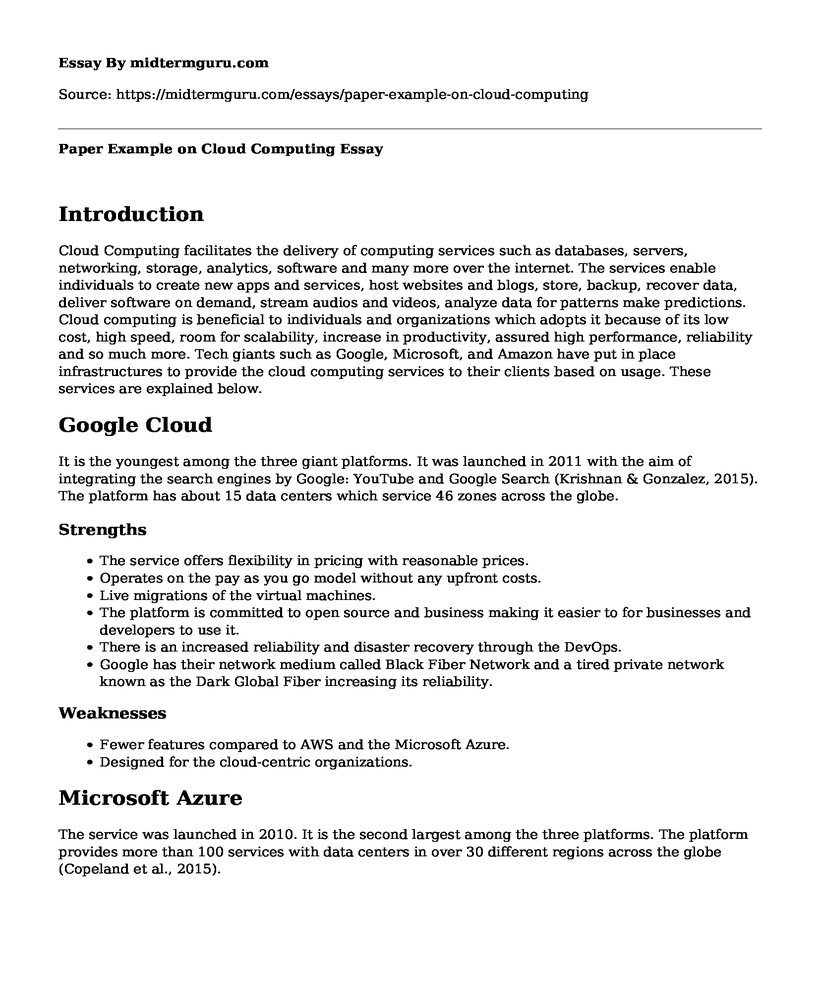Introduction
Cloud Computing facilitates the delivery of computing services such as databases, servers, networking, storage, analytics, software and many more over the internet. The services enable individuals to create new apps and services, host websites and blogs, store, backup, recover data, deliver software on demand, stream audios and videos, analyze data for patterns make predictions. Cloud computing is beneficial to individuals and organizations which adopts it because of its low cost, high speed, room for scalability, increase in productivity, assured high performance, reliability and so much more. Tech giants such as Google, Microsoft, and Amazon have put in place infrastructures to provide the cloud computing services to their clients based on usage. These services are explained below.
Google Cloud
It is the youngest among the three giant platforms. It was launched in 2011 with the aim of integrating the search engines by Google: YouTube and Google Search (Krishnan & Gonzalez, 2015). The platform has about 15 data centers which service 46 zones across the globe.
Strengths
- The service offers flexibility in pricing with reasonable prices.
- Operates on the pay as you go model without any upfront costs.
- Live migrations of the virtual machines.
- The platform is committed to open source and business making it easier to for businesses and developers to use it.
- There is an increased reliability and disaster recovery through the DevOps.
- Google has their network medium called Black Fiber Network and a tired private network known as the Dark Global Fiber increasing its reliability.
Weaknesses
- Fewer features compared to AWS and the Microsoft Azure.
- Designed for the cloud-centric organizations.
Microsoft Azure
The service was launched in 2010. It is the second largest among the three platforms. The platform provides more than 100 services with data centers in over 30 different regions across the globe (Copeland et al., 2015).
Strengths
- Can be provided in Platform as a Service, Infrastructure as a Service and Software as a Service supporting private, public, and hybrid computing as well as open source servers.
- It is easier to integrate the Microsoft productivity tools and software with the Microsoft Azure platform.
- Azure supports both the SQL and NoSQL databases.
- The platform users' page blobs and temporary storage for VM based columns.
- Supports Windows and Linux operating systems.
- The platform a security layer broken into five layers comprising of data, application, host, network, and physical.
Weaknesses
- It is not friendly to large enterprises.
- Inability for the upload of custom images by the clients.
- Lack of Hyper-V snapshot support.
- Does not support integrated backups.
Amazon Web Services
It is the first cloud service to be launched. AWS has the largest market share compared to Microsoft Azure and the Google Cloud Compute. AWS provides over 70 services covering more than 16 regions across the world (Amazon, 2015).
Strengths
- It is the dominant cloud platform among the three.
- It is scalable and can support large organizations.
- Offers the new subscribers a 12-month free membership.
- It offers extensive training for new members for 12 months.
- Support Windows and Linux operating systems.
- Offers a buffer memory for each instance created.
- Supports SQL and NoSQL databases.
- The platform has a security layer broken into five layers comprising of data, application, host, network, and physical.
Weaknesses
- Not user-friendly with overwhelming options for the new users.
- Expensive in the long run.
- Charges tech support fees.
Recommendation
Among the three cloud platforms, AWS leads regarding maturity and functionalities. Amazon has an expansive list of tools as well as services that make it the best proposition for the larger organizations. However, the existing gap between these cloud computing providers is becoming thinner each day. Microsoft Azure is working tirelessly to bridge the existing gap. Microsoft has invested heavily in the development of their Azure cloud platform and to strengthen its ties with their software services making it the best bet in the future. Thus, I would recommend the use of the Azure cloud platform due to the future it holds.
References
Amazon, E. C. (2015). Amazon web services. Available in: http://aws. amazon. com/es/ec2/(November 2012).
Copeland, M., Soh, J., Puca, A., Manning, M., & Gollob, D. (2015). Microsoft Azure and cloud computing. In Microsoft Azure (pp. 3-26). Apress, Berkeley, CA.
Krishnan, S. P. T., & Gonzalez, J. L. U. (2015). Google compute engine. In Building Your Next Big Thing with Google Cloud Platform (pp. 53-81). Apress, Berkeley, CA.
Cite this page
Paper Example on Cloud Computing. (2022, Sep 23). Retrieved from https://midtermguru.com/essays/paper-example-on-cloud-computing
If you are the original author of this essay and no longer wish to have it published on the midtermguru.com website, please click below to request its removal:
- Haraways Cyborg Theory and Digital Communication Technologies
- Essay on Mitigating the Factors for the Client Service for Netware
- Implementation of the Cyber Security Plan in the Electronic Health Systems
- Application Letter to MSc in Software Engineering
- Software Requirements Specification - Essay Sample
- Internet: Blessing or Curse? The Debate Rages On - Essay Sample
- Understaffing: Is Management Ignorant of the Problem? - Essay Sample







